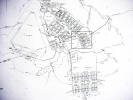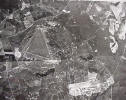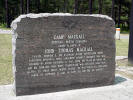|

The regiment moved into its new home on March 25, 1943. From then until December 19, 1943, the regiment conducted advanced and specialized training as well as spending six weeks on the famous Tennessee maneuvers. |
|

Camp Mackall Map shows unusual triangular runway layout and a large parachute packing support area.

Aerial
photo is a near duplicate for the map

Division Training Center and Barracks (front center) |
 Army troops first came to the U.S. Department of the Interior's game management land in the Hoffman area in 1941 during the Carolina Maneuvers. That area is about 40 miles west of Fort Bragg on the west side of Drowning Creek. Army troops first came to the U.S. Department of the Interior's game management land in the Hoffman area in 1941 during the Carolina Maneuvers. That area is about 40 miles west of Fort Bragg on the west side of Drowning Creek.
During the 1920s, the Baltimore Barber Steamship Company established a hunting preserve there. In 1922 they created Mossgeil Lake and constructed a log cabin on the east shore. It became the commander's house during World War II.
In 1924 a second cabin was built on the west shore, which served as a briefing room during the war and is now the Range Control Office.
. In 1930, DuPont Corporation purchased the property and added a lodge, which became Camp Mackall's Officers Club. That building burned in 1968, but the chimney remains.
On November 8, 1942, construction began on the Hoffman Airborne Camp on 56,002.91 acres obtained from the Department of Interior and purchased from local landowners. There were over 1,750 buildings erected mostly of the Theater of Operations (T/O) type. The one-story T/O buildings were the most temporary construction with rough plank siding covered with tarpaper. A heavier grade tarpaper served as roofing material.
Construction included seven service clubs, two guesthouses, three libraries, 16 post exchanges, 12 chapels, a hospital, 65 miles of roads and three 5,000
foot runways in a triangle. Those buildings included headquarters for the U.S. Army Airborne Command, the garrison command and the division headquarters. There were also numerous service buildings. The camp's cantonment area was constructed with a north and south area separated by about a mile with the Station Hospital in between closer to the north area. The south barracks area was for troops in training and contained all the services necessary to sustain them. Those troops began arriving in January 1943. They were to receive basic training there in addition to perfecting their parachuting and gilder skills.
|
|
 On February 8, 1943, General Order Number 6 renamed the facility Camp
Mackall in honor of Private John Thomas (Tommy) Mackall. He was born
May 17, 1920 in Ohio and grew up in Wellsville, Ohio. He served in the
2nd Battalion, 503rd Parachute Infantry Regiment. During the Allied
invasion of North Africa in the airborne segment called Operation Torch,
he was mortally wounded in an attack by French Vichy aircraft on his
aircraft as it landed near Oran. Seven paratroopers died at the scene
and several were wounded, including Mackall. He was evacuated by air
to a British hospital at Gibraltar where he died on November 12, 1942.
Tommy Mackall's mother and two brothers were among family members attending
the camp dedication
On February 8, 1943, General Order Number 6 renamed the facility Camp
Mackall in honor of Private John Thomas (Tommy) Mackall. He was born
May 17, 1920 in Ohio and grew up in Wellsville, Ohio. He served in the
2nd Battalion, 503rd Parachute Infantry Regiment. During the Allied
invasion of North Africa in the airborne segment called Operation Torch,
he was mortally wounded in an attack by French Vichy aircraft on his
aircraft as it landed near Oran. Seven paratroopers died at the scene
and several were wounded, including Mackall. He was evacuated by air
to a British hospital at Gibraltar where he died on November 12, 1942.
Tommy Mackall's mother and two brothers were among family members attending
the camp dedication
on May 1, 1943. A bronze
plaque recalling the event that injured Mackall was unveiled at a ceremony
that day and installed at the division headquarters building. It was
later removed when the camp was dismantled. In the 1970s it was misplaced
and never found. A granite monument now stands at the camp entrance.
The U.S. Army Airborne Command was moved to Camp Mackall
in early 1943 from Fort Bragg. While the 82nd and 101st Airborne Divisions
remained garrisoned at Fort Bragg, they were trained under the Command
at Camp Mackall before leaving for assignments elsewhere that year.
Some of the regiments attached to the divisions trained at Camp Mackall.
The first airborne division headquartered at Camp Mackall was the 11th
Airborne Division reporting on February 25, 1943. The 17th Airborne
Division was activated there on April 25, 1943. The 13th Airborne Division
was activated on August 13, 1943, and moved from Fort Bragg to Camp
Mackall in January 1944
|





